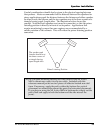
About the M1 Active Mk2
M1 Active Mk2 Reference Manual 15
ABOUT NEARFIELD MONITORING
In the early days of recording, most recording studios used big monitor
speakers almost exclusively. Unfortunately, they also required high powered
amplifiers and expensive acoustic treatment (often poorly done) of the entire
control room. Still, a well-constructed big monitoring system really was
impressive to listen to, a fact not overlooked by the studio owners who
wanted to impress the record company executives who paid for the big
studio's time. These big systems had big level control knobs, and clients
enjoyed "cranking-up" the volume. Fortunately, recording engineers and
producers eventually learned that this was not the best way to accurately mix
music because it wasn't the way most people listened to their radios, cassettes
and CD players. Also, big monitor systems and the costs for the required
control room acoustic treatments were going through the roof (no pun
intended), particularly beyond the budget limits of smaller project and home
studios which were growing in numbers. A new way of accurate monitoring
was needed: nearfield monitoring.
Nearfield monitors, by their definition, are intended for mounting close to the
listener. The idea here is to improve the direct acoustic path between the
speaker and the listener by making it shorter, thereby giving less opportunity
for the always present indirect (reflected) sounds to get back in and muddle
things up. With nearfield monitoring, the surrounding acoustic environment
becomes a much less significant factor in establishing the monitor system's
sound character.
A good set of small monitors properly placed in a reasonably non-reverberant
room and properly powered will yield surprisingly accurate results at budget
prices. Carried to another studio, the same monitor should also provide
repeatable results. In fact, some recording engineers carry their own speakers
around because they know how they will sound in almost any room. Now,
even the big studios use smaller speakers to augment their big monitoring
systems, and nearfield monitors have become proven tools in the recording
business.


















